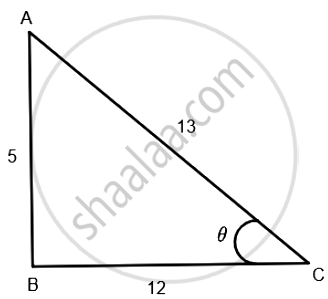Advertisements
Advertisements
Question
If `cos theta = 12/13`, show that `sin theta (1 - tan theta) = 35/156`
Solution
Given: cos θ = `12/13`
To prove: sin θ (1 − tan θ) = `35/156`
Proof: we know, cos θ = `B/H`
where the right-angled triangle's base is B and its hypotenuse is H. ∠ACB = 8 is achieved by building a right triangle ABC at a right angle to B.
AB is perpendicular, BC = 12 is base, and AC = 13 is hypotenuse. According to Pythagoras theorem, we have
AC2 = AB2 + BC2
132 = AB2 + 122
169 = AB2 + 144
169 − 144 = AB2
25 = AB2
AB = `sqrt25` = 5

sin θ = `P/H = 5/13`
So, tan θ = `P/H = 5/12`
Put the values in sin θ(1 − tanθ) to find its value,
sinθ(1 − tanθ) = `15/3 (1 - 5/12)`
= `5/13 xx 7/12 = 35/156`
Hence Proved.
APPEARS IN
RELATED QUESTIONS
In ΔABC right angled at B, AB = 24 cm, BC = 7 m. Determine:
sin A, cos A
If cot θ = `7/8`, evaluate cot2 θ.
In the following, trigonometric ratios are given. Find the values of the other trigonometric ratios.
`cos theta = 7/25`
If `sin theta = a/b` find sec θ + tan θ in terms of a and b.
If Cosec A = 2 find `1/(tan A) + (sin A)/(1 + cos A)`
Evaluate the following
cos 60° cos 45° - sin 60° ∙ sin 45°
If `sqrt2 sin (60° – α) = 1` then α is ______.
The value of cos 0°. cos 1°. cos 2°. cos 3°… cos 89° cos 90° is ______.
If sin θ + sin² θ = 1, then cos² θ + cos4 θ = ______.
Find will be the value of cos 90° + sin 90°.
